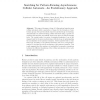Free Online Productivity Tools
i2Speak
i2Symbol
i2OCR
iTex2Img
iWeb2Print
iWeb2Shot
i2Type
iPdf2Split
iPdf2Merge
i2Bopomofo
i2Arabic
i2Style
i2Image
i2PDF
iLatex2Rtf
Sci2ools
ACRI
2004
Springer
2004
Springer
Searching for Pattern-Forming Asynchronous Cellular Automata - An Evolutionary Approach
This paper discusses a class of 2-dimensional asynchronous cellular automata with conservation of mass, for the formation of patterns in groups. The previous study reported a methodology of searching, automatically, for pattern-forming cellular automata using a genetic algorithm; this approach successfully found a few types of pattern-forming rules. The current study is a series of statistical analyses of one of the classes found by the above methodology, with the hope of understanding the mechanisms of the pattern formation. These analyses lead to some basic logic necessary to the pattern formation, but not to enough information to elucidate the whole mechanism of the pattern formation. This result suggests that the existence of unidentified cooperative operations between the different transitions of the cellular automaton rule to carry out the pattern formation.
| Added | 30 Jun 2010 |
| Updated | 30 Jun 2010 |
| Type | Conference |
| Year | 2004 |
| Where | ACRI |
| Authors | Tomoaki Suzudo |
Comments (0)

